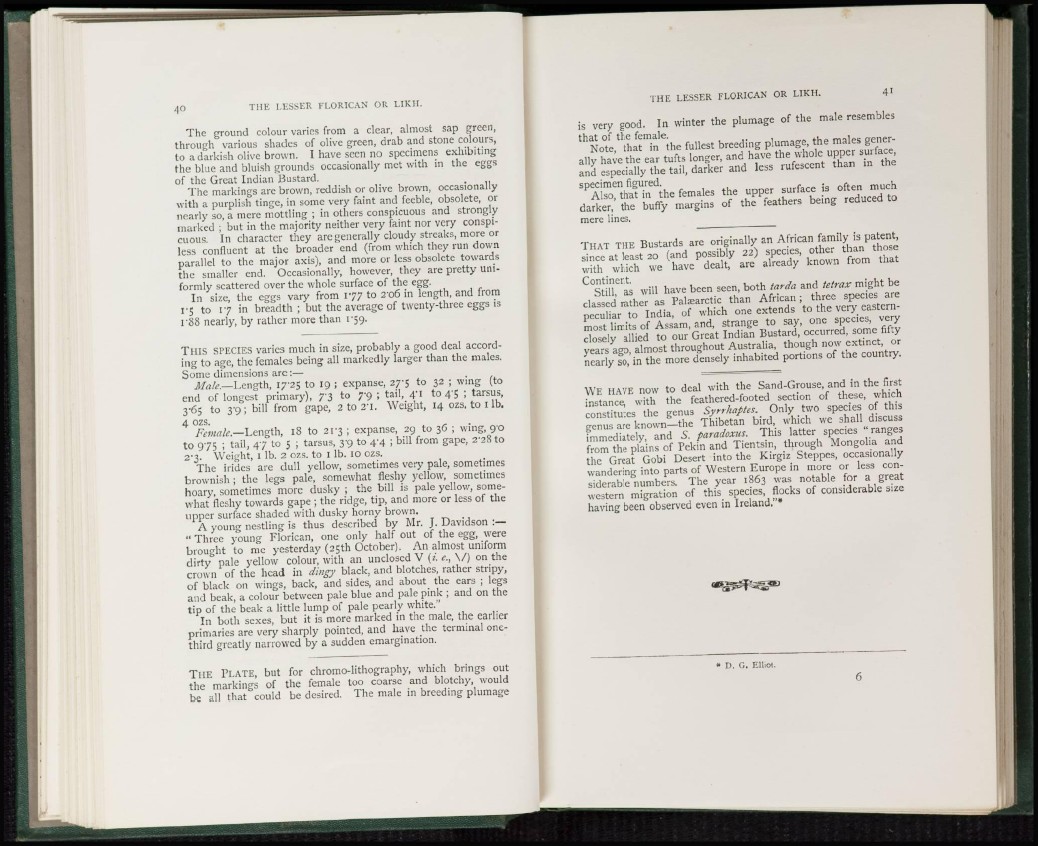
The ground colour varies from a clear, almost sap green,
through various shades of olive green, drab and stone colours,
to a darkish olive brown. I have seen no specimens exhibiting
the blue and bluish grounds occasionally met with in the eggs
of the Great Indian Bustard.
The markings are brown, reddish or olive brown, occasionally
with a purplish tinge, in some very faint and feeble, obsolete, or
nearly so, a mere mottling ; in others conspicuous and strongly
marked ; but in the majority neither very faint nor very conspicuous.
In character they are general!}'cloudy streaks, more or
less confluent at the broader end (from which they run down
parallel to the major axis), and more or less obsolete towards
the smaller end. Occasionally, however, they are pretty uniformly
scattered over the whole surface of the egg.
In sue, the eggs vary from 177 to 2'o6 in length, and from
1 '5 to 17 in breadth; but the average of twenty-three eggs is
1 "S8 nearly, by rather more than 1-59.
T i n s SPECIES varies much in size, probably a good deal according
to age, the females being all markedly larger than the males.
Some dimensions arc:—
Male.—Length, I7'25 to 19 ; expanse, 27-5 to 32 ; wing (to
end of longest primary), 7 3 to 7-9 ; tail, 4'i to 45 ; tarsus,
3-65 to 3'9; bill from gape, 2 to 2'i. Weight, 14 ozs. to 1 lb.
4 ozs.
Female.—Length, 18 to 21*3 ; expanse, 29 to 36 ; wing, 90
to 975 ; tail, 4 7 to 5 ; tarsus, 3-9 to 4-4 ; bill from gape, 2'28 to
2'3- Weight, 1 lb. 2 ozs. to I lb. 10 ozs.
The irides are dull yellow, sometimes very pale, sometimes
brownish ; the legs pale, somewhat fleshy yellow, sometimes
hoary, sometimes more dusky ; the bill is pale yellow, somewhat
fleshy towards gape ; the ridge, tip, and more or less of the
upper surface shaded with dusky horny brown.
A young nestling is thus described by Mr. J. Davidson :—
" Three young Florican, one only half out of the egg, were
brought to mc yesterday (25th October). An almost uniform
dirty pale yellow colour, with an unclosed V (i. e., \/) on the
crown of the head in dingy black, and blotches, rather stripy,
of black on wings, back, and sides, and about the ears ; legs
and beak, a colour between pale blue and pale pink ; and on the
tip of the beak a little lump of pale pearly white."
In both sexes, but it is more marked in the male, the earlier
primaries are very sharply pointed, and have the terminal onethird
greatly narrowed by a sudden emargination.
THE PLATE but for chromo-lithography, which brings out
the markings of the female too coarse and blotchy would
be all that could be desired. The male in breeding plumage
is very good. In winter the plumage of the male resembles
that of the female.
Note, that in the fullest breeding plumage, the males generally
have the ear tufts longer, and have the whole upper surface,
and especially the tail, darker and less rufescent than in the
specimen figured.
Also, that in the females the upper surface is often much
darker, the buffy margins of the feathers being reduced to
mere lines.
THAT THE Bustards are originally an African family is patent,
since at least 20 (and possibly 22) species, other than those
with which we have dealt, are already known from that
Continent.
Still, as will have been seen, both tarda and tetrax might be
classed rather as Palaearctic than African ; three species are
peculiar to India, of which one extends to the very easternmost
limits of Assam, and, strange to say, one species, very
closely allied to our Great Indian Bustard, occurred, some fifty
years ago, almost throughout Australia, though now extinct, or
nearly so, in the more densely inhabited portions of the country.
WE HAVE now to deal with the Sand-Grouse, and in the first
instance, with the feathered-footed section of these, which
constitutes the genus Syrrhaptes. Only two species of this
genus are known—the Thibetan bird, which we shall discuss
immediately, and S. paradoxus. This latter species " ranges
from the plains of Pekin and Tientsin, through Mongolia and
the Great Gobi Desert into the Kirgiz Steppes, occasionally
wandering into parts of Western Europe in more or less considerable
numbers. The year 1863 was notable for a great
western migration of this species, flocks of considerable size
having been observed even in Ireland."*
* D. 0. Elliot.